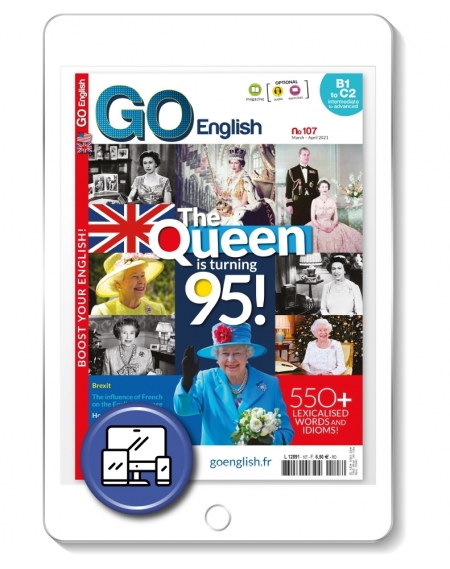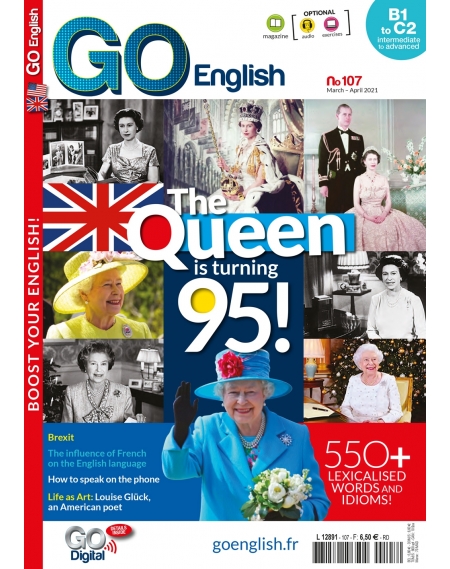- Menu
-
Blog
Actualité anglophone
Le monde anglophone, sa langue et sa culture vous intéressent ? Pour satisfaire votre curiosité, suivez notre blog et retrouvez un nouvel article chaque semaine : recettes, idées voyage, culture, actualité, etc.
➞ Cliquez ici
- Abonnements
- Couplage
- Numérique + audio
- Autres produits
- Accès abonné
- Espace prof
-
Qui sommes-nous
Votre partenaire pour les langues
Créée en 1996, la société d’édition presse Entrefilet est le spécialiste de l’apprentissage du français langue étrangère (avec la gamme Bien-dire) et de l’anglais (avec la gamme Go English).
-

THE GRAMMAR POINT from Go English no107
‘The’ – Part 2 (B1-C2)
In our previous edition we looked at the devious nature of the article ‘the’, which is the most common word– and perhaps the most difficult to use – in the English language.
The basic rule we all learn about the definite article is simple: if we’ve mentioned it before; if we know which one we’re talking about; if there is only one of them, then we use ‘the’ instead of ‘a’ or ‘an’. Thus, if the noun that comes after has been previously ‘defined’, we use the definite article: ‘the’.
The problem, of course, is the incredible amount of exceptions to this rule, as well as aspects to the use of the word that have nothing to do with whether or not the corresponding noun has been previously defined. We’ll be looking at some more of these exceptions and other aspects of the use of “the” below.
Typically troublesome
We often use ‘the’ to talk about ‘types’ or categories of things. These ‘types’ can often be food, musical instruments, artistic and literary genres, plants or animals.
Look at these examples:
The tomato is the most photographed food on Instagram.
The satirical newspaper has a long history in modern times, dating back to Mark Twain and beyond.
In these sentences, we aren’t talking about any tomato or satirical newspaper in particular, but about tomatoes and satirical newspapers in general. Thus, we can say the same thing by making the nouns plural:
Tomatoes are the most photographed food on Instagram.
Satirical newspapers have a long history in modern times, dating back to Mark Twain and beyond.
We can use the same construction to talk about categories of people as well; it’s important to note that here, too, we are not speaking about any one individual, but about the general category of people.
For example:
The civil rights militant of the 1960s was very likely to be involved in the non-violent protest movement.
Meaning the same thing as:
Civil rights militants of the 1960s were very likely to be involved in the non-violent protest movement.
On the contrary, we cannot use the indefinite article to the same effect:
A civil rights militant of the 1960s was very likely to be involved in the non-violent protest movement.
Definitive adjectives
One use of the definite article flies completely in the face of what lower level learners are told about it, which is that we use articles with nouns. In fact, it’s possible to use “the” with adjectives, when these adjectives represent a category or group.
Here are some examples:
The young were more likely to take part in the civil rights movement than older people. The poor are just as likely as the rich to want to look at pictures of beautifully presented food.
When used in this way, this category or group is always conjugated in the plural, not the singular form. You cannot use these adjectives in the singular: “The young is...” or “The poor is...”.
Nations and nationalities
We saw in the previous article on ‘the’ that most – but not all – countries do not take a definite article because, just as with the names of individuals, these are also proper names.
Japan (not “the Japan”) is known for its shokuhin sampuru food models.
However, when we are referring to groups of people of certain nationalities, we do use the definite article. This is the case for these nationality words: the Welsh, the British,
the French, the Dutch, the Swiss, the English, the Irish, the Spanish.
The British benefitted enormously from the opening of the Eurotunnel.
It was a joint project carried out by both the British and the French.
In addition to these, all nationality words that end in ‘ese’ can also take the definite article.
Note that nationality words are always conjugated in the plural, and the pronouns associated with the nationalities also treat them as plural.
The Japanese are (not “is”) known for their (not “its”) shokuhin sampuru food models.
Article by Mohamed Oummih
E-Go English n°107
Mars-avril 2021
Elizabeth II, le plus long règne de l'histoire britannique
• Quels changements avec le Brexit ?
• Comment parler au téléphone en anglais
• Louise Glück, poétesse américaine primée
• L'utilisation de l'article « the »
• L'histoire du tunnel sous la Manche
• John Lewis, militant et homme politique américain
Attention au Copyright :
*Les contenus lus, écoutés en ligne ou téléchargés par l’utilisateur sont des fichiers numériques protégés par le droit d’auteur et plus généralement, par le droit de la propriété intellectuelle. Leur utilisation ne pourra être effectuée que dans un cadre strictement privé. Dès lors, l’utilisateur s’engage à ne pas copier, modifier, reproduire, décompiler le contenu, ni conférer quelque sous licence que ce soit.
Dans le cas d’une utilisation en classe, les professeurs d’anglais peuvent obtenir une autorisation de partage des contenus avec leurs élèves. Pour cela, ils doivent en faire la demande auprès des Éditions Entrefilet à contact@editions-entrefilet.fr et s’acquitter de droits qui seront calculés au cas par cas.
Ce site Web utilise ses propres cookies et ceux de tiers pour améliorer nos services et vous montrer des publicités liées à vos préférences en analysant vos habitudes de navigation. Pour donner votre consentement à son utilisation, appuyez sur le bouton Accepter.
Plus d'informationsConfiguration des cookies
- Cookies tiers à des fins d'analyse.
- Afficher des recommandations personnalisées en fonction de votre navigation sur d'autres sites
- Afficher des campagnes personnalisées sur d'autres sites Web
- Nécessaire pour naviguer sur ce site et utiliser ses fonctions.
- Vous identifier en tant qu'utilisateur et enregistrer vos préférences telles que la langue et la devise.
- Personnalisez votre expérience en fonction de votre navigation.






